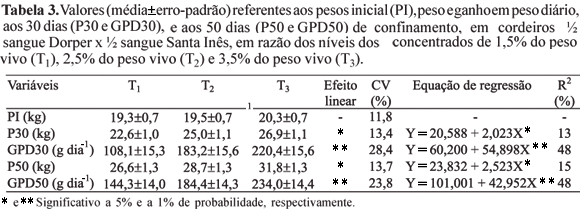The objective of this work was to evaluate bioeconomic efficiency of F1 Dorper x Santa Inês lambs for meet production. Performance of F1 Dorper x Santa Inês lambs in raising and fattening phases was analyzed. The production phase of lambs was realized in native pastures ("caatinga") and the finishing phase was in confinement. The ewes were supplemented during the last 50 days of pregnancy and the first 30 days of lactation. Lambs were weaned at 70 days of age, divided into three lots, confined and fed elephant grass (Pennisetum purpureum) ad libitum, and concentrate in the proportion of 1.5%, 2.5% and 3.5% of live weight, respectively. Lambs sex did not have significant influence on birth weight, as well as on weaning weight and weight gain until weaning. In production and confinement phases, lambs of single births were superior to double births ones considering these variables. Linear effect was significant for weight and for weight gain, at 30 and 50 days of confinement. The three inclusion levels of concentrate were economically viable. Gross margins of live weight for each kg of lamb produced were R$ 0.26 kg-1, R$ 0.30 kg-1 and R$ 0.36 kg-1 of live weight to concentrates of 1.5%, 2.5% and 3.5%, respectively. The best economics results were obtained when the concentrate level was 3.5% of live weight.
sheep; crossbreeding; body weight; weight gain; confinement; economic viability






